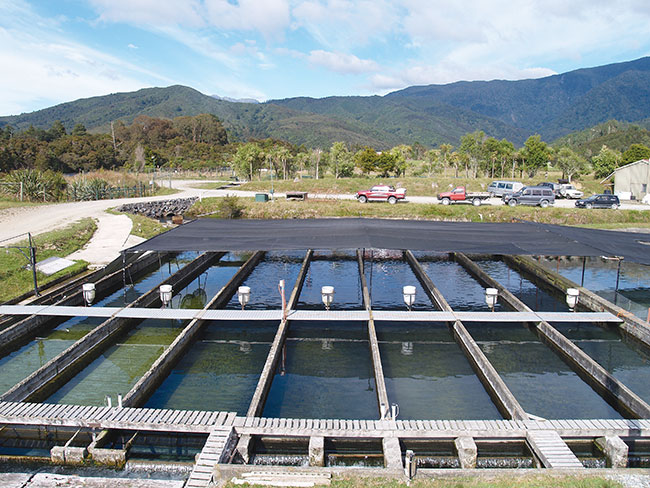
Uncategorized
Features
Opinion
Industry Update
Sustainability
Viewpoint: I blame the Australian weather
Aquaculture faces a great opportunity to become a serious contributor of animal-based protein in these challenging times.
March 27, 2024 By John Mosig
 Open, flow-through salmon broodstock holding pens. (Photo: John Mosig)
Open, flow-through salmon broodstock holding pens. (Photo: John Mosig) I read the 2024 Hatchery Outlook for Australia a few months ago with more concern than embarrassment. Written in November, it took aboard, as we all did, the usually predictable weather patterns that have been associated with El Niño Southern Oscillations (ENSO) and positive Indian Ocean Dipoles (IOD): hot and dry in the eastern and northern parts of Australia.
Instead, these regions have been bombarded by torrential rain events since December. In Far North Queensland (FNQ), Cyclone Jasper inundated the region with up to 2.5 metres of rain. It was the first time a cyclone has collected there in December during an El Niño since records began. Based on wind force, it was designated as Category 2. Normally, for experienced communities, this would be inconvenient, but manageable. It was not the case. Jasper became what meteorologists call a stationary convergence zone. It hung around for six days; movement was impossible; essential supplies were a serious issue, and the extent of the material damage was catastrophic.
Landslides blocked roads; rivers cut new courses; one in three bridges were unusable; long stretches of tarmac were ripped up; hundreds of homes were wrecked. Power and sewerage plants were still inoperative weeks after the cyclone eventually passed over. The infrastructure repair bill will be in the billions; the cost to the local economy – based on tourism, sugar cane and fresh tropical produce, including fisheries and aquaculture – is incalculable.
Coral reefs, already weakened by bleaching, were smashed and vast tracts of seagrass were rolled up and dumped ashore. As plumes of precious agricultural topsoil spread on a 750-kilometre front across it, the Reef’s future, as a living organism, became a disheartening concern.
Mango, banana, paw paw and avocado plantations were severely damaged and much of the season’s crop spoiled beyond recovery. The region is a major supplier of 2-3 kilogram barramundi. Flooded growers lost up to two years of fish growth. The region is also a major supplier of home-grown shrimp. Producers face delivery problems across a disrupted transport system.
It wasn’t only the far north that copped a battering from unseasonal weather. Right down the east coast as far as Victoria, random rain bombs caused major flooding and created havoc. Moreover, temperatures in areas not under clouds were brain-sizzling high. Then it turned dry a cross the south regions and bushfire updates became the news headlines.
While this was unfolding in Australia, the people of Europe and Northern Asia and America were struggling to cope with extremes of weather in a Northern Hemisphere winter. It is becoming frighteningly clear that not only is our weather becoming more extreme, it’s becoming seasonally unreliable.
The author of many epic novels of humanity’s progress over the ages, James Michener, wrote in 1978, “We are mankind because we survive. We do it in a half-arsed way, but we do it.”
From what’s being witnessed across the world, there can be no denying, that right now we’re facing a defining moment in that progress. It presents the aquaculture industry with a great opportunity to become a serious contributor of animal-based protein in these challenging times.
For its ecological impact, real or perceived, aquaculture has long been branded a pariah by environmental activists. In striving for its own survival, the industry could well become the hero of the global step into a food-secure future, and remove that stigma.
Moreover, reduction in greenhouse gas emissions will become a crucial marketing issue. Sustainability, already a certifiable brand image, will become even more so.
RAS technology has come of age over the last few decades. The marriage of water chemistry, nutritional and genetic science, and the artform of fish husbandry has been consummated and finfish are being produced economically around the world in closed systems. More than that, site selection, so critical to open systems, ceases to be an issue. The climate-controlled systems, to minimize carbon miles, can be built close to their markets, service industries and feed manufacturers. AI is only going to make the technically advanced systems more efficient and cheaper to run.
The aquaculture industry can take another step into the future here, too. Advances in battery technology and alternative power generation have already reached commercially viable levels and will only improve. So how far away is the first off-grid fish farm? Recirculation systems use a lot of power, so an off-grid model may be fanciful, but the reality is that we need to reduce our emissions by 50 per cent just to hold temperature increase to 1.5 C. That would give the industry a reasonable target at which to aim.
An energy-challenged future will be sure to drive innovations. One worth considering in RAS farms may be based on the amount of water moved. Creative engineering could develop a way to strip energy from that movement and apply it to hydro-energy generation. Methane captured from filtered tank waste could be used to generate power. All micro resolutions in the overall, but when the actuality of climate change hits, we’ll be living in tomorrow’s world.
To date, enclosed systems have been used mainly by hatcheries and, because of their feeding habits, finfish production. At some stage, the weather risks of open crustacean farms will drive the growers to establish ways in which a market worth over US$60 billion can be supplied from climate-proof systems. Home aquariums have used under-gravel filters for ages. Adapting them in systems for demersal species shouldn’t be impossible. Having live shrimp to sell in Manhattan or Beijing would have to be a lucrative carrot for the sector.
Incorporating filter feeders in the biological chain offers another revenue option.
While some of the above is conjecture, it’s no more science fiction than say, 50 years ago, having a multipurpose communication and monetary device that tells the time strapped to your wrist would have been. Now that yesterday’s climate doomsayer is tomorrow’s prophet, the aquaculture sector, like so many food producers, has some reinvention ahead of itself.
Fish farming may well be the last of the hunter-gatherers to come in from the cold, but by its very nature, it has a great opportunity to become the future lead source of animal protein. And a healthy one at that.
 John Mosig is considered to be one of the pioneers of Australian warmwater aquaculture. His 43 years of experience at a commercial level has given him a clear understanding of the economic drivers of the industry. He has served on several sector and industry peak bodies. He has designed and delivered training programs, and written two books on the subject, both published by CSIRO Publishing.
John Mosig is considered to be one of the pioneers of Australian warmwater aquaculture. His 43 years of experience at a commercial level has given him a clear understanding of the economic drivers of the industry. He has served on several sector and industry peak bodies. He has designed and delivered training programs, and written two books on the subject, both published by CSIRO Publishing.
Print this page
Advertisement
- CSIRO’s AquaWatch technology completes initial testing
- Scottish Sea Farms incubation unit receives first set of eggs





